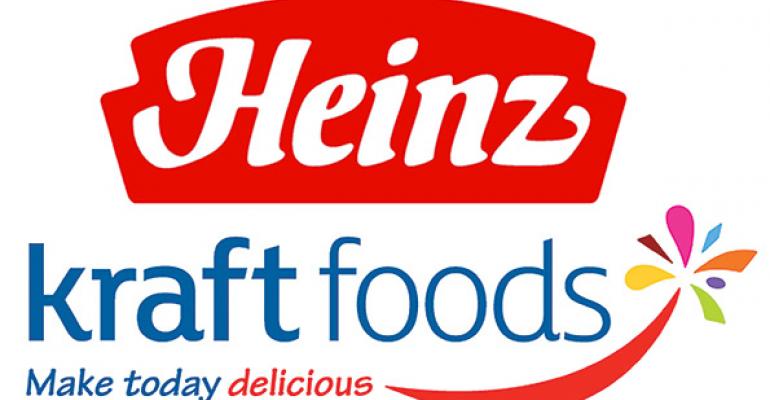Kraft Foods Group Inc. and H.J. Heinz Co. announced plans Wednesday to merge in a deal that would create the third-largest packaged food business in the U.S., as well as a major supplier of products to restaurants and foodservice companies.
The new entity will be called the Kraft Heinz Company, and will be co-headquartered in Chicago and Pittsburgh. It would be the fifth-largest packaged food company in the world, with $28 billion in annual revenue and eight brands worth $1 billion or more.
The deal also represents another massive acquisition for 3G Capital, the Brazilian private-equity firm that owns Heinz, as well as Restaurant Brands International, parent of both Burger King Corp. and Tim Hortons Inc. 3G has been reportedly eyeing other deals since its purchase of Tim Hortons last year, an acquisition that created the world’s third-largest restaurant company.
“This transaction is all about growth,” said Alex Behring, managing partner of 3G Capital, who will be chairman of the combined company, during a conference call Wednesday.
Behring noted that Heinz’s global presence “should help Kraft expand its iconic brands internationally, while Kraft’s robust North American platform provides a strong opportunity for Heinz brands.”
Heinz and Kraft are known more for their packaged foods businesses in retail, but both are major foodservice suppliers. Heinz Ketchup is the dominant brand in quick-service chains and other restaurants. Kraft sells Philadelphia Cream Cheese, Grey Poupon Mustard and A1 Steak Sauce, along with a large selection of hot and cold beverages, including Tang, Capri Sun and Maxwell House coffee.
According to its recent annual report, Kraft’s “other businesses” revenues, including foodservice, totaled more than $1.9 billion.
Executives with the combined companies suggested the deal should enable the companies to use their new scale to generate additional revenue through their combined foodservice business.
“The company will benefit from its scale and relationship across the foodservice sector,” said John Cahill, CEO and chairman of Kraft, who will be vice chairman of Kraft Heinz.
Under the deal, shareholders of Kraft will each get $16.50 per share in cash as a “special dividend,” totaling $10 billion and funded through an equity injection from 3G Capital and investor Warren Buffett’s Berkshire Hathaway. Kraft shareholders will also get one share of the combined company for every share they own.
3G and Berkshire bought Heinz in 2013, and also worked together on the Burger King–Tim Hortons merger.
Berkshire and 3G Capital will own 51 percent of Kraft Heinz, and Kraft shareholders will own 49 percent. Bernardo Hees, CEO of Heinz, will be CEO of the combined company. The deal is expected to close in the second half of the year.
“This is my kind of transaction, uniting two world-class organizations and delivering shareholder value,” Buffett said in a statement. “I’m excited by the opportunities for what this new combined organization will achieve.”
Executives of the brands suggested they would use 3G Capital’s playbook to build value at the combined company. 3G Capital is known for deep cuts in general and administrative spending, along with aggressive expansion into new markets.
“We and our partners at 3G are shareholders of several global consumer companies,” Behring said, noting that it also owns beverage company AB/InBev. “We’ve taken a long-term approach to investing, building strong global consumer brands. We’ve worked with the team at Heinz to transform every aspect of the business. We plan to take the same playbook to Kraft that we used at Heinz to create long-term value to shareholders.”
The companies estimate that synergies created by the merger should enable them to save $1.5 billion in costs every year through increased scale, sharing best practices and cost reductions.
The deal should help Kraft expand its brands internationally. Kraft has seven brands with retail sales of $1 billion or more, and has “near total penetration in the American market,” Cahill said. The average consumer has 10 Kraft products in their home at any one time, he said.
But, while noting that Kraft has 80-percent name recognition in 14 international markets, he called that an “untapped opportunity.”
Kraft was spun off from what is now called Mondelez International in 2012. That deal restricted Kraft’s ability to bring its brands to certain markets. Those restrictions are about to be lifted. Heinz already has infrastructure in many markets where Kraft has brand awareness, which should enable Kraft’s brands to expand quickly in places like Australia, China, Italy, Brazil and Indonesia.
“We should be able to realize that potential in the very near term,” Cahill said.
“The entire industry has faced headwinds, and change has been continuous,” he said. “We have talked about accelerating the pace of change in a fast-moving landscape to create a lean, nimble, global champion. This allows us to move faster than we could on our own.”
Contact Jonathan Maze at [email protected]
Follow him on Twitter: @jonathanmaze

